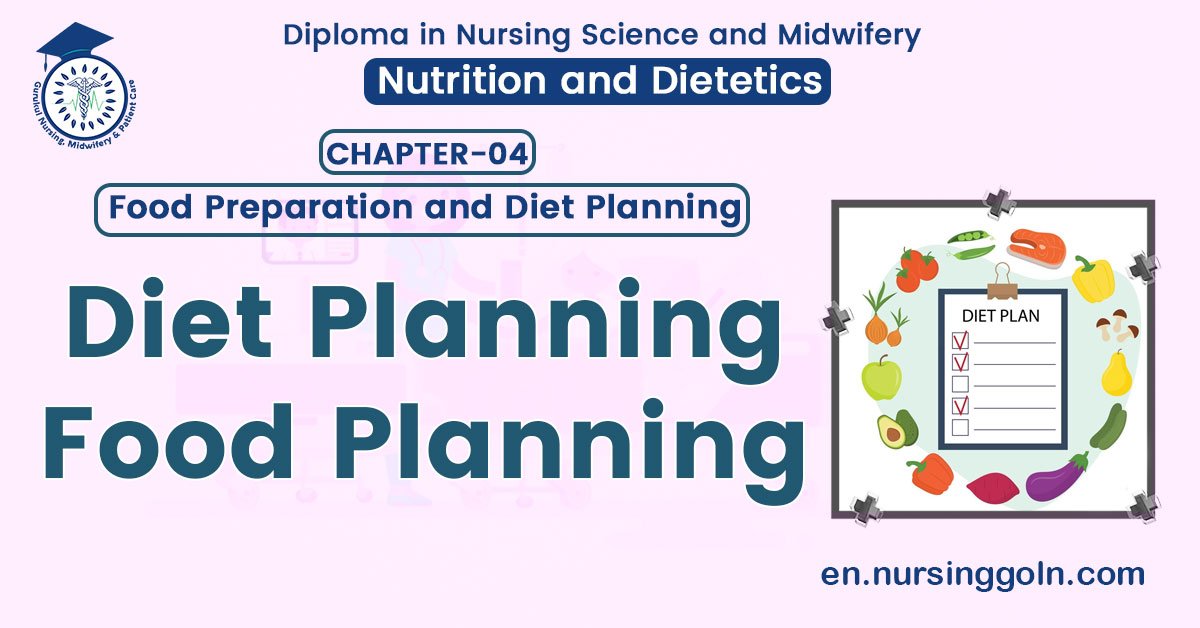Diet Planning/Food Planning – This book covers the entire syllabus of “Nutrition and Dietetics” prescribed by BNMC-for all Diploma in Nursing Science and Midwifery students. We tried to accommodate latest information and topics. This book is examination friendly setup according to the teachers’ lectures and examination’s questions. At the end of the book previous university questions are given. We hope in touch with the book students’ knowledge will be upgraded and flourished. The unique way of presentation may make your reading of the book a pleasurable experience.

Diet Planning/Food Planning
It is necessary for individual as well as for group to meet the need, planning is need to supply adequate diet. Which fulfill all the needs of body for heat, energy, growth, repair, protection and regulation factors for planning of food.
(Ref: Nursing Lecture/Mohakhali Nursing Institute)
Criteria of planning of food:
1. Number of family members.
2. Types of works.
3. Food customs of the family.
4. Economic condition of the family.
5. Availability of food/high and low cost.
6. The special nutritional need of infant, children, pregnant and lactation mother.
For individual- especially for children:
1. Black yellow and green leafy vegetables.
2. Meat, fish, peas and pulses.
3. Bread, rice.
4. Milk, cheese and milk product, butter, ghee, oil for availability.
Principle of Diet Planning
- Adequacy – Provides sufficient energy and enough of the nutrients to meet the needs of most healthy people to maintain their health.
- Balance diet- Eat a variety of foods to obtain all the nutrients.
- Nutrient Density – A measure of the nutrients a food provides relative to the energy it provides. The more nutrients and the fewer k calories, the higher the nutrient density.
- Calorie/Energy control – Managing energy intake.
- Moderation – Select foods low in fat and sugar, they promote weight gain.
- Variety – Select foods from different food groups
Another Answer:
Principle of Diet/ Food Planning:
1. It is necessary to plant foods needed daily by the family properly in order to ensure get nutrition.
2. A well plant meal proves to be a time energy and money saver. It is also avoid unwanted, unappetizing and unsatisfying meals.
3. In order to make the based used of money available” It is important to plant the meals for a family which a low budget to ensure sufficient and nutritionally balance food.
4. Meal plant need to be flexible enough to take into account changer due to price fluctuation, seasonal foods, family tastes and desires holydays special /family function and guests.
5. Every number of family request the save basic food however the quality may have to alter according to the age and special need of the individual for as example; Milk is required in larger amount by children than adults, children smaller quantities of fond than adults. Old people might require of food.
6. Meat, trim meat, use of boiling, stemming testing rather than dip frying. Use more fresh food and vegetable than sweat and derived and the methods of cooking should also be considered as for example; To reduce weight, use skin milk, instill of whole milk.
7. Changer in the family meal may be made any member of family is under therapeutic control of a disease as for example, Diabetic, hypertension. Good meal planning is both science and art.
8. Since shows as the way to include nutritious food in the diet. When art is involved in combining the needed nutritious food into meals that are attractive.
(Ref: Nursing Lecture/B.A Siddikey R. C. N. Institute)

Diet of a Pregnant Woman:
1. Energy intake: An additional minimum intake of 200 kcal/day during the second and third trimesters.
2. Proteins: An additional allowance of 14 g/day of dietary protein.
3. Other nutrients: A regular and adequate intake of all other nutrients, specially iron, folic acid and calcium.
Additional allowance for pregnant mother:
| Food items | Amount | Calories (Kcal) |
| Cereals | 35 g | 118 |
| Pulses | 15 g | 52 |
| Milk | 100 g | 83 |
| Sugar | 10 g | 40 |
| Total | 293 | |
Ref: K. Park/23)
Diet of a Lactating Mother:
1. Energy intake: Additional intake of 550 kcal//day for the first 6 months and 400 kcal/day for the period from 6 months to 1 year.
2. Proteins: An additional allowance of 25 g/day.
3. Other nutrients: A regular and adequate intake of all other nutrients, specially vitamin C.
| Food items | Amount | Calories (Kcal) |
| Cereals | 60 g | 203 |
| Pulses | 30 g | 105 |
| Milk | 100 g | 83 |
| Sugar | 10 g | 40 |
| Fat | 10 g | 90 |
| Total | 521 | |
(Ref: K. Park/23)

Energy Requirement:
With advance in age, there is increase in calorie requirements of the child due to more physical activities on their part. The energy requirement of a child aged 1 year is about 1,000 kcal/day. After the age of 1 year, the energy needs can be computed by adding 100 kcal for every year of life. Thus, a child aged 5 years needs 1500 kcal/day.
1. Proteins: Extra proteins are needed to ensure proper growth of their tissues. 8-10% of the energy need may be given as proteins calcium and phosphorus are required for the growth of bones and teeth.
2. Iron for haemoglobin.
3. Adequate amount of vitamins
(Ref: K. Park/24)
Read more:
